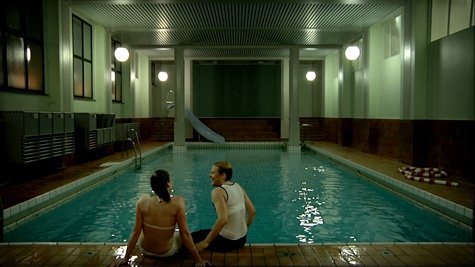| 
Accordingly, this is why documentaries such as Saskia Bisp’s new film Nobody Passes Perfectly are so important. This 45-minute long film centres around two trans men – Tomka and Erik – thereby focusing on a group of people that not only constitutes a minority within LGBT coalitions, but also has a minority voice within transgender community as a whole.[8] When it comes to representation, trans individuals have often been exploited and sensationalised by others with little concern for the lives and perspectives of the trans people themselves.[9] This is fortunately not the case here. |  | ![[8] Kate O’Riodan, “Transgender activism](Resources/item1a3a1b1b.gif)
| 
|  |  | 
|  | | 
|  |  | 
|  |  | 
|  |  | Nobody Passes Perfectly consists of a series of loosely connected scenes linked together via a thin narrative thread. We follow Tomka, a trans man in his early thirties, and the little older trans man Erik who is his late forties. It is shot with a static camera that records only one shot per scene, often in rather long and stylized takes. The long takes facilitate conversation, giving voice and representation to the characters. These conversations take place in arranged tableaus that are evocative and aesthetically beautiful emphasised by the background music composed especially for the film. It reminds me in some ways of Roy Anderson’s Songs from the Second Floor (2000), but without the absurdist comedy dimension. Apparently none of the scenes were thoroughly scripted or storyboarded, but the tableaus were carefully arranged and thought through in order to create the right atmosphere and aesthetics.[10] The chosen locations are all places where gendered and sexual identities come into being and where they are policed. We are in a public swimming pool, bathrooms, a fitness centre, a bed, a club, a bar, and a restaurant. Many of these rooms require that you are “readable at a glance” and if you are not, you will be perceived as “gender deviant”.[11] |  | ![[10] According to Saskia Bisp](Resources/item1a3a1b1ba.gif)
| 
|  |  | 
|  | | 
|  |  | 
|  |  | 
|  |  | The film tries to integrate a beautiful visual expression with substantial discussions that do the protagonists justice. However, the film is not structured as a progressive story, whereby it avoids repeating the well-known trans narratives tracing the journey from one gender incarnation to another with certain benchmarks (typically childhood memories, coming out to friends and family, first shot of testosterone, top surgery, change in legal gender status).[12] Unlike many other trans documentaries and video blogs on YouTube which centre on the body in transition through hormones and/or surgery, Nobody Passes Perfectly explores transgenderism as a feeling or a perception of oneself. The audience is not initiated in medical procedures and how these affect the body. Only implicitly, and drip by drip, does the audience become aware that both of the two protagonists, Tomka and Erik, take testosterone and that Erik has had a top surgery. |  | ![[12] J. Seipel drew my](Resources/item1a3a1b1b1.gif)
| 
|  |  | Accordingly, the film is somehow political, but focuses only indirectly on the debates about the medical and legal apparatus of sex. Instead, the film takes its point of departure in the director’s own curiosity concerning how and why somebody chooses to become a man – and what the transition does to what previously was perceived as a lesbian relationship.[13] The investigation is frank as we get very close to the people on screen through the long tableau shots, often with close-ups of naked or semi-naked bodies and intimate conversations. Sometimes it seems as if the movie is too intimate with the result that I as a spectator get slightly claustrophobic. I cannot help being a little overwhelmed by the intimate situations and conversations that I feel I was not supposed to witness. This feeling of invading the private sphere is obviously somewhat paradoxical, taken into the account that the scenes are clearly staged. |  | | 
|  |  | 
|  | | 
|  |  | 
The press coverage of Nobody Passes Perfectly bears witness to a general invisibility and ignorance about transgenderism. Two well-reputed film experts reported the film incorrectly in their otherwise very positive reviews. The film critic Michael Bo writes, “A young couple are lying in bed, a long-haired feminine woman and a short-haired masculine trans who is becoming a woman but technically is still a man”.[14] Michael Bo is referring to the lead protagonist Tomka (“short-haired masculine trans who is becoming a woman but technically is still a man”) and his girlfriend Lotte (“long-haired feminine woman”). But Tomka was not assigned the male gender at birth and he is not becoming a woman but a man. The quote highlights that trans people are often exclusively associated with trans women, thereby surfacing that trans men are an invisible and almost unthinkable group of people. This misreading also confirms another phenomenon, namely that many FtMs (Female to Male), contrary to MtFs (Male to Female), pass as the desired gender after just a few months on testosterone. |  | ![[14] Michael Bo, “Guide: Filmfestival](Resources/item1a3a1b1b2a.gif)
| 
|  |  | In an article in the film magazine Ekko, film professor Ib Bondebjerg writes, “There are also a lot of bodies in Saskia Bisp’s intense investigation of homosexual identities in Nobody Passes Perfectly. We are among common people and couples who struggle with gender identity and bodily problems pertaining to the transgression of your biological gender”.[15] According to this review, the film is primarily about “homosexual identities”, which is not quite the case. The quote highlights a common misconception, namely that trans is equivalent to homosexual. But whereas homosexual refers to a sexual preference, trans refers to a gender identity. However, sexual orientation is questioned as the film explores the sexual labelling and un-labelling of couples once one of them decides to transition. As Tomka says, “What are the categories for it?”, then asking Lotte, “What categories fit for you – lesbian?” Apparently Lotte identifies as lesbian, but she is, as Tomka says, “together with a man”. The question is whether the homosexual category has ever been relevant or adequate for them as a couple, even as the heterosexual category does not seem applicable either. For Lotte it does not matter whether Tomka identifies as a man or not. That will not change her feelings or their relationship, but she is afraid that they as a couple will be perceived differently. His transition will eliminate the queerness about them as a couple and her position will change as well. She will, as she says, be read differently when she is together with a partner who passes as male than when she is together with one that passes as female. She will be perceived “as a woman”. This statement points to a feeling of being “womanized” in a more profound way when she is together with someone who is read as a man – as if manhood installs and reinforces womanhood. |  | ![[15] Ib Bondebjerg, “Talenter med](Resources/item1a3a1b1a1aa.gif)
| 
|  |  | 
|  |  |
|